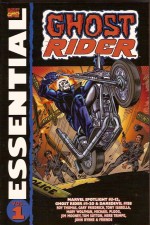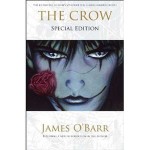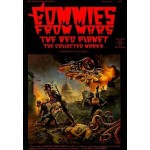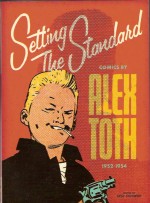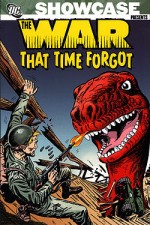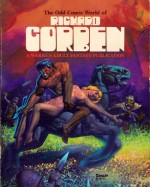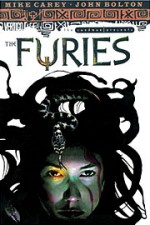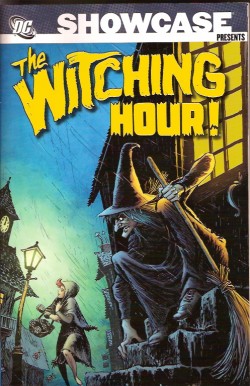
By Alex Toth & various (DC Comics)
ISBN: 978-0-85768-196-6
American comicbooks started slowly until the creation of superheroes unleashed a torrent of creative imitation and invented a new genre. Implacably vested in the Second World War, the Overman swept all before him (and the far too occasional her) until the troops came home and more traditional genres supplanted the Fights ‘n’ Tights crowd.
Although new kids kept up the buying, much of the previous generation also retained their four-colour habit but increasingly sought older themes in the reading matter. The war years altered the psychology of the world, and as a more world-weary, cynical young public came to see that all the fighting and dying hadn’t really changed anything, their chosen forms of entertainment (film and prose as well as comics) reflected this. As well as Western, War and Crime comics, madcap escapist comedy and anthropomorphic funny animal features were immediately resurgent, but gradually another periodic revival of spiritualism and interest in the supernatural led to a wave of increasingly impressive, evocative and even shocking horror comics.
There had been grisly, gory and supernatural stars before, including a pantheon of ghosts, monsters and wizards draped in mystery-man garb and trappings (The Spectre, Mr. Justice, Sgt. Spook, Frankenstein, The Heap, Dr. Fate and dozens of others), but these had been victims of circumstance: the unknown as a power source for super-heroics. Now the focus shifted to ordinary mortals thrown into a world beyond their ken or control with the intention of unsettling, not vicariously empowering the reader.
Almost every publisher jumped on the increasingly popular bandwagon, with B & I (which became the magical one-man-band Richard E. Hughes’ American Comics Group) launching the first regularly published horror comic in the Autumn of 1948, although Adventures Into the Unknown was technically pipped by Avon who had released an impressive single issue entitled Eerie in January 1947 before launching a regular series in 1951, by which time Classics Illustrated had already long milked the literary end of the medium with adaptations of the Headless Horseman, Dr. Jekyll and Mr. Hyde (both 1943), The Hunchback of Notre Dame (1944) and Frankenstein (1945) among others.
If we’re keeping score this was also the period in which Joe Simon and Jack Kirby identified another “mature market†gap and invented the Romance comic (Young Romance #1, September 1947) but they too saw the sales potential for spooky material, resulting in the seminal Black Magic (launched in 1950) and boldly obscure psychological drama anthology Strange World of Your Dreams (1952).
The company that would become DC Comics bowed to the inevitable and launched a comparatively straight-laced anthology that nevertheless became one of their longest-running and most influential titles with the December 1951/January 1952 launch of The House of Mystery.
When the hysterical censorship scandal which led to witch-hunting hearings (feel free to type Senate Subcommittee on Juvenile Delinquency, April-June 1954 into your search engine at any time… you can do that because it’s notionally a free country now) was curtailed by the industry adopting a castrating straitjacket of self regulatory rules.
HoM and its sister title House of Secrets were dialled back into rationalistic, fantasy adventure vehicles, which dominated the market until the 1960s when super-heroes (which had started to creep back after Julius Schwartz began the Silver Age of comics by reintroducing the Flash in Showcase #4, 1956) finally overtook them. Green Lantern, Hawkman, the Atom and a slew of other costumed cavorters generated a gaudy global bubble of masked mavens which even forced the dedicated anthology suspense titles to transform into super-character split-books.
However nothing combats censorship better than falling profits and at the end of the 1960s the Silver Age superhero boom stalled and crashed, leading to the surviving publishers of the field agreeing to loosen their self-imposed restraints against crime and horror comics. Nobody much cared about gangster titles at that time but as the liberalisation coincided with another bump in global interest in all aspects of the supernatural, the resurrection of scary stories was a foregone conclusion and obvious “no-brainer.†Even the ultra wholesome Archie comics re-entered the field with their rather tasty line of Red Circle thrillers…
With Tales of the Unexpected from #105 and House of Mystery #174 the company switched to anthology horror material before creating an all-new title to further exploit the morbid fascination with the fearsome and spooky (they even resurrected the cancelled House of Secrets in late 1969) for those heady days when it was okay – and profitable – to scare the heck out of little kids by making them laugh.
Edited until #14 by Dick Giordano, The Witching Hour first struck at the end of 1968 (with a February/March 1969 cover-date). From the outset it was an extremely experimental and intriguing beast and this amazingly economical Showcase Presents collection reprints the first 19 issues, completely covering the first three years as the fear fad grew to become the backbone of DC’s sales. It is perhaps the most talent-stuffed title of that entire period.
Here the usual cool and creepy horror hosts who introduced the tales were three witches – based as much on Macbeth as the ancient concept of Maiden, Mother and Crone – a torrid trio who constantly battled to outdo or out-gross each other in the telling of terror tales. Moreover, Cynthia, Mildred and Mordred – as well as shy monster man-servant Egor – were designed and usually drawn by master artist Alex Toth; making the framing sequences between yarns as good as and sometimes better than the stories they brazenly bracketed.
One minor quibble: records from the period are not complete and occasionally a creator is unknown, but this volume also sadly misattributes the artist too. I’ve attempted to correct the mistakes when I’m certain, but please be warned and beware – I’m not always right either…
Following a stunning Nick Cardy cover, Toth starts the ball rolling by introducing the sinister sisters and their ongoing contest before Dennis O’Neil & Pat Boyette relate the story of a time-travelling tap-dancer in ‘Save the Last Dance For Me’, after which Toth writes and illustrates a compelling period piece of peril in ‘Eternal Hour!’ and Jack Sparling relates the eerie fate of wave-obsessed Stanley’s search for ‘The Perfect Surf’. Toth’s scary sisters then close out the premier issue (with, I suspect, additional inks from Neal Adams), but still find room for ‘Silk Gauze’, an informational page by persons unknown which first appeared in Tales Unexpected #126.
Although attributed to Toth, #2’s introductory episode is by his old Standard Comics stable-mate Mike Sekowsky (inked by Giordano) and leads into Sparling’s dream-chiller ‘Scream!’, after which young José Delbo delineates a shocking period tale of slavery and vengeance ‘The Trip of Fools!’ before Sid Greene’s short ghost story ‘The Beat Goes On!’ and Sparling’s ‘Once Upon a Surprise Ending!’ end an issue regrettably short on writer credits.
Following another Sekowsky/Giordano intro, Toth & Vince Colletta illustrated Don Arneson’s medieval mood masterpiece ‘The Turn of the Wheel!’, whilst Alan Riefe & Sparling told a decidedly different ghost-story in ‘The Death Watch’, after which Steve Skeates & Bernie Wrightson revealed a very alterative fantasy hero in ‘…And in a Far-Off Land!’, followed by the first of a series of short prose vignettes: an anonymous fright-comedy entitled ‘Potion of Love’.
Toth illustrated the sisters’ ‘Witching Hour Welcome Wagon’ (a useful identifying rule of thumb for the uninitiated is that the master usually signed his work – and was allowed too…) after which new kid Gerard Conway spectrally scripted ‘A Matter of Conscience’ for art veterans Sparling & George Roussos. Another anonymous prose piece ‘If You Have Ghosts’ preceded a smashing yarn entitled ‘Disaster in a Jar’ by Riefe & Boyette and Conway scripted the period witchfinder thriller ‘A Fistful of Fire’ for Delbo – a vastly underrated artist who was on the best form of his career at this time.
Toth’s Weird Sisters closed out that issue and eerily, hilariously opened #5 before Wrightson lavishly embellished a nifty but uncredited (as is every script in this one) nautical nightmare ‘The Sole Survivor!’, followed by text-teaser ‘The Non-Believer!’ and Boyette’s stunning, clownish creep-feature ‘A Guy Can Die Laughing!’, whilst Stanley Pitt & Giordano’s dating dilemma ‘The Computer Game’ was one of the first to explore that now-hoary plot. After Toth signs off the witches, there’s an added one-page black-comedy bonus from Sid Greene with ‘My! How You’ve Grown!’
Sekowsky & Giordano limned Dave Kaler’s take on the sisters’ intro for The Witching Hour #6 after which a far darker horror debuted in ‘A Face in the Crowd!’ by Conway, Mike Roy & Mike Peppe, as a Nazi war criminal and a concentration camp survivor met in an American street; Marv Wolfman & Delbo described a tale of neighbourly intolerance in ‘The Doll Man!’ and ‘Treasure Hunt’ by Skeates, John Celardo & Giordano showed why greed isn’t always good. Also included were Conway’s prose tale ‘Train to Doom’, ‘Mad Menace’ – a half-page gag strip by John Costanza – and ‘Distortion!’ another Greene-limned one-pager.
Toth & Mike Friedrich were on spectacular form for #7’s introduction and bridging sequences, and Bill Draut was compulsively effective in prison manhunt saga ‘The Big Break!’ whose scripter Steve Skeates also wrote modern-art murder-mystery ‘The Captive!’ for Roussos, after which Friedrich & Jack Abel advised a most individual baby to ‘Look Homeward, Angelo!’. Text piece ‘Who Believes Ouija?’ and Jack Miller & Michael Wm. Kaluta’s gothically lovely ‘Trick or Treat’ round out the sinister sights in this issue.
Sergio Aragonés & Neal Adams provided the witch-bits for #8, bracketing their own satanically sardonic ‘Above and Beyond the Call of Duty!’, as well as ‘Three Day Home Trial!’ (Aragonés & Cardy) and the staggeringly inventive ‘Computerr’ by that man again and Toth. ‘The Career Man’ was a witty but anonymous prose piece and the issue closed with a Twice Told Tale by Ron Whyte & Sparling, as an urban myth was revealed in ‘The Sign of the Hook!’
Toth & Draut began #9, after which Bob Brown & Murphy Anderson illustrated ghostly tale ‘The Long Road Home!’ and, after text story ‘The Dark Well’, the peripatetic, post-apocalyptic, ironic occasional series ‘The Day after Doomsday’ by Len Wein & Sparling made a welcome appearance. Delbo delightfully delineated a terrifying tale of Old China in ‘The Last Straw’ and, after George Tuska took over the Weird Sisters linking-segments, a doomsday debacle closed the dramas with a ‘Trumpet Perilous!’ drawn by Sparling & Abel.
The witches’ opening issue #10 were once more by Toth & Draut, promptly followed by a magnificent illustration job by the great Gray Morrow on the regrettably uncredited ‘A Warp in Time… Loses Everything!’ – work inestimably improved by being seen in monochrome – after which the all-word ‘I’ll See You in My Dreams’ preceded Conway & Toth’s superb forbidden romance ‘Hold Softly, Hand of Death!’. Tuska handles the Sisters before Sparling’s faux-fact page ‘Realm of the Mystics’ ends this excursion into the dark.
Toth drew the intro and Jack Oleck’s ‘The Mark of the Witch’ (inked by Draut) in #11, whilst – after text-tale ‘Retired Undefeated!’ – Tuska inspirationally illustrated the creepy chronal conundrum ‘The Sands of Time, the Snows of Death!’, and The Witching Hour #12 was similarly blessed, as after a sinisterly sexy Skeates/Toth intro the devilish duo then described an horrific ‘Double Edge’ battle between witch-queens and valiant mortals, followed by a Machiavellian actor’s ‘Double Take’ (Skeates & Tuska) and a demonic duel and ‘Double Cross!’ by Skeates & Gil Kane. The ever-anonymous prose piece was the mordantly merry ‘The Dead Can’t Talk But…’
Giordano’s last issue was editor was #13, which opened in grand style as fellow comicbook hosts Cain, Abel and the Mad Mod Witch (from Houses of Mystery and Secrets and The Unexpected respectively) attended ‘New Year’s Eve at the Witching Hour’ (illustrated by Neal Adams) followed by a marvellously experimental and effective psycho-thriller by Alan Gold & Gray Morrow entitled ‘The Maze’, a far more traditional but no less scary story ‘The Accursed Clay!’ (Miller, Sparling & Frank Giacoia) and the just plain strange tale of ‘The Rush-Hour Ride of Abner Pringle!’, by Wein & Delbo. As an added treat the text token was ‘The Witching Hour Mistree’ by that shy but not retiring rogue Egor…
When veteran editor Murray Boltinoff assumed the reins with #14 (April-May 1971) an element of experimentalism was surrendered but the more conventional material was no less welcomed by the horror-hungry readership: more proof, if any were needed, that artistic endeavour and envelope-pushing aren’t to everybody’s taste. George Tuska replaced Toth as regular illustrator of the introductory and bridging sections, but otherwise most fright-seeking kids could hardly tell the difference.
The all-science fiction issue’s terror-tales began with a beautiful but oddly stilted yarn from Conway and Jeff Jones who explored the solitary burdens of ‘Fourteen Months’ in deep space, whilst ‘Which Witch is Which?’, by Kaler, drawn by Stanley & Reg Pitt, related the comeuppance of an intergalactic Lothario. As “Al Caseâ€, Editor Boltinoff provided the text feature ‘Dead Letter Office’ and the issued ended on a classic visual high note with ‘The Haunted House in Space!’ illustrated by the dream team of Al Williamson & Carlos Garzon.
After the usual ghastly graphic girl talk TWH #15 started with a murder masterpiece from George Kashdan & Wally Wood revealing that ‘Freddy is Another Name For Fear!’, after which Al Case scripted ‘End of a World’ before Phil Seuling & Gray Morrow stole the show with the fearsome fable of the ‘Bayou Witch’ and Case & Art Saaf rang down the curtain with ‘I Married a Witch!’
Issue #16 saw House of Mystery expand from 32 to 52 pages – as did all DC titles for the next couple of years, opening the doors for a superb period of new material and the best of the company’s prodigious archives to an appreciative, impressionable audience. The mysterious magic began after Tuska’s punchy prelude with the cautionary ‘Never Kill a Witch!’ by Carl Wessler, John Calnan & Bernie Case, after which Boltinoff – as Bill Dennehy – provided a slick and edgy reinterpretation of a classic fairytale for Morrow to lavishly limn in ‘The Spell of Sinner Ella!’ before switching back to his Case persona for the Tony DeZuniga illustrated duelling drama ‘You Can’t Hide From Death’. The classic reprints began with ‘The Wondrous Witch’s Cauldron’ (drawn by the legendary Lee Elias from House of Secrets #58), followed by a Joe Orlando illustrated, Charles King scripted text piece ‘Last Meal’ and Howie Post and Draut’s ghoulish period parable ‘The Curse of the Cat’ which both first saw print in House of Mystery #177.
Kashdan & Heck opened #17 with a modern magic myth in ‘This Little Witch Went to College’ after which a classic 1950’s fear-feature from Sensation Mystery Comics #109 saw Carmine Infantino & Joe Giella devastatingly depict the ‘Fingers of Fear!’ whilst from House of Secrets #46, Howard Sherman delineated ‘The Second Life of Simon Steele’. Dennehy, Calnan & Colletta provided a new yarn with an old moral in ‘The Corpse who Carried Cash!’ before Wessler & mood-master Jerry Grandenetti fantastically finished the fear-fest with ‘The Man in the Cellar’.
The same team opened #18 with ‘The Worm that Turned to Terror’, a schizophrenic slice of domestic hell followed by ‘The Diggers!’ a nasty, vengeful yarn from Bobs Haney and Brown with Giacoia inks that encompassed half a century of French war and regret. Tales of the Unexpected #13 was the original source of both the Ed Herron/Jack Kirby conundrum ‘The Face Behind the Mask’ and the Herron/Cardy creepy-crime caper ‘I Was a Prisoner of the Supernatural’, after which modernity returned with Jim Aparo’s ‘Hypnotic Eye’ and the Kashdan, Calnan & Colletta cautionary tale ‘When Satan Comes Calling!’
The final issue in this superbly spooky compendium is The Witching Hour #19, which, after the customary Tuska drawn kaffeeklatsch with Mordred, Mildred and Cynthia, commences in a stylish, sparkling Jack Phillips & Grandenetti chiller ‘A Tomb for the Winning!’, swiftly followed by ‘The Four Threads of Doom’ (by anonymous & Cardy from Tales of the Unexpected #12) after which a different anonymous and Tuska provided a fresh new thriller in ‘Stop Beating, Heart! You’re Killing Me!’. One final Cardy reprint ‘The Lamp That Changed People!’ (House of Mystery #20) follows before this wonderful debut volume of witchly wonderment concludes with the Kashdan/Elias shocker ‘What Evil Haunts This House?’
These terror-tales captivated the reading public and critics alike when they first appeared and it’s likely the supernatural sector saved DC during one of the toughest downturns in comics publishing history. Now their blend of garish mordant mirth, classic horror scenarios and suspense set-pieces can most familiarly be seen in such children’s series as Goosebumps, Horrible Histories and their many imitators.
If you crave beautifully realised, tastefully gore-free sagas of tension and imagination, not to mention a huge supply of bad-taste, kid-friendly cartoon chaos, stay up past The Witching Hour as long and as often as you possibly can…
© 1969, 1970, 1971, 1972, 2011 DC Comics. All Rights Reserved.

